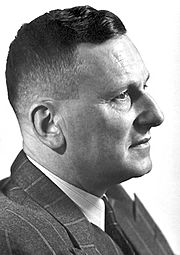Paul Hermann Müller facts for kids
Quick facts for kids
Paul Hermann Müller
|
|
|---|---|
 |
|
| Born | 12 January 1899 |
| Died | 13 October 1965 (aged 66) |
| Nationality | Swiss |
| Alma mater | Universität Basel |
| Known for | Insecticidal applications of DDT |
| Awards | Nobel Prize in Physiology or Medicine (1948) |
| Scientific career | |
| Fields | Chemistry |
| Institutions | J. R. Geigy AG |
| Doctoral advisor | Hans Rupe |
Paul Hermann Müller was a Swiss chemist. He is famous for discovering that DDT could kill insects. This discovery helped control diseases like malaria and yellow fever. He won the Nobel Prize in Physiology or Medicine in 1948 for his important work.
Contents
Paul Müller's Early Life and School Days
Paul Müller was born on January 12, 1899, in Olten, Switzerland. He was the oldest of four children. His family moved often because his father worked for the Swiss Federal Railways. They lived in Lenzburg and then in Basel.
A Young Scientist's Home Lab
Even when he was young, Paul loved science. He had a small laboratory at home. There, he developed photos and built radio equipment. His grades in school sometimes suffered because he spent so much time on his experiments.
Education and University
In 1916, Müller left school for a short time. He worked as a lab assistant. But he went back to school in 1918 and finished his diploma in 1919. That same year, he started studying chemistry at Basel University. He also studied botany (plants) and physics. He earned his PhD in 1925.
Working at Geigy and Discovering DDT
In 1925, Müller started working as a research chemist at J. R. Geigy AG in Basel. At first, he worked on dyes and tanning agents. These are chemicals used to treat leather.
Protecting Plants from Pests
Müller was very interested in protecting plants. He loved nature and wanted to find ways to keep crops safe from insects. In 1935, he began looking for a new insecticide. An insecticide is a chemical that kills insects.
At that time, many insecticides were expensive or not very good. Some were even harmful to people and animals. Müller wanted to find a chemical that would only harm insects. He wanted it to be strong, long-lasting, and cheap to make.
The Search for a Solution
Müller spent four years searching for this perfect insecticide. He tried 349 different compounds. Finally, in September 1939, he found it. He put a fly in a cage with a special compound. A short time later, the fly died.
This compound was dichlorodiphenyltrichloroethane, known as DDT. Another scientist had first made DDT in 1874. But that scientist didn't realize how useful it was. Müller quickly understood that DDT was the chemical he had been looking for.
DDT's Amazing Power
Tests showed that DDT was incredibly effective. It worked against many pests, including:
- The Colorado potato beetle
- Mosquitoes, which spread malaria
- Lice, which spread typhus
- Fleas, which spread the plague
- Sandflies, which spread other tropical diseases
How DDT Changed the World
Geigy started selling DDT products in 1940. The name DDT became widely known in 1943.
Saving Lives During War
DDT played a huge role during World War II. It helped save millions of lives. It stopped the spread of diseases like typhus among soldiers and people in war zones.
Fighting Malaria
Between the 1950s and 1970s, DDT helped get rid of malaria in many countries. This included the United States. It was a powerful tool in public health.
Müller's Later Career and Honors
In 1946, Müller became a Deputy Director at Geigy. In 1948, he received the Nobel Prize in Physiology or Medicine. This was a huge honor, especially since he was a chemist, not a doctor. The Nobel Committee recognized that DDT had saved countless lives.
Other Awards and Retirement
Müller received many other honors. He got an honorary doctorate from a university in Greece. This was because DDT had helped almost wipe out malaria in that region. He retired from Geigy in 1961 but continued his research at home.
Paul Müller's Personal Life
Paul Müller married Friedel Rüegsegger in 1927. They had two sons, Heinrich and Niklaus, and one daughter, Margaretha. His wife took care of their home and children. This allowed Müller to focus on his chemistry work.
Hobbies and Interests
In his free time, Müller loved nature. He enjoyed the Swiss Alps and the Swiss Jura. He had a small holiday home there. He also had a small fruit farm. He liked gardening, taking photos of wildflowers, and going on nature walks with his children. He and his wife also enjoyed playing music together.
Müller was known for being independent and determined. His daughter called him an Eigenbrötler, which means "one who makes his own bread." He died on October 13, 1965, in Basel, surrounded by his family.
Honors
Paul Hermann Müller received many awards for his work. Greece especially honored him for helping to almost eliminate malaria in their country. In 1963, he was celebrated as a national hero there.
- Nobel Prize in Physiology or Medicine 1948
- Honorary member of the "Swiss Nature Research Society" 1949
- Honorary member of the "Paris Society of Industrial Chemistry" 1949
- Honorary member of the "Reale Accademia Internazionale del Parnaso (Napoli)" 1951
- Medal of Honour of the "Congrès Internationale de Phytopharmacie et Phytiatrie (Paris)" 1952
- Honorary member of the "Academia Brasileira de Medicina Militar (Rio de Janeiro)" 1954
- Honorary doctorate at the Universidad Nacional Eva Perón
- Honorary professorship at the "Escuela Superior Tecnica e Investigacion Cientifica (Buenos Aires)"
- Honorary doctorate at the Aristotle University of Thessaloniki 1963
- Golden medal of the city of Thessaloniki 1963
See also
In Spanish: Paul Hermann Müller para niños

